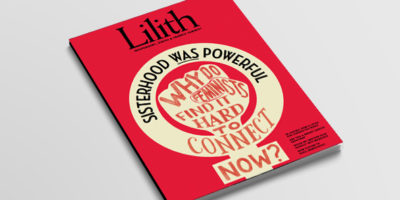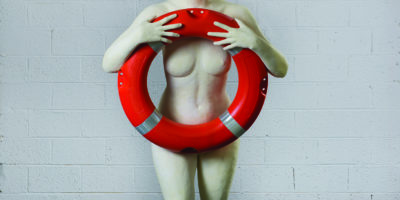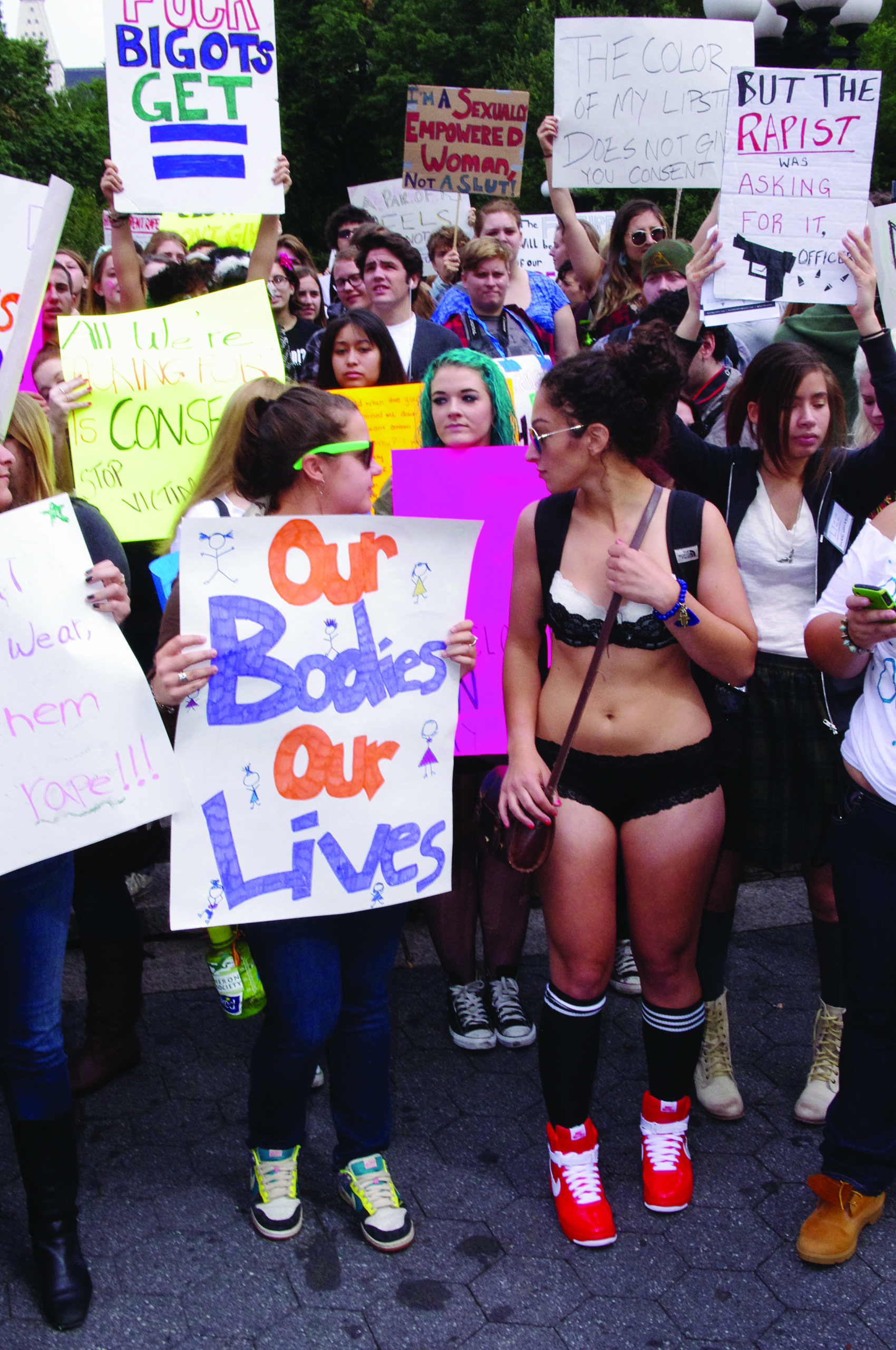
Confronting Generational Tensions to Build Our Badass Jewish Feminist Future
What makes 3 generations of Jewish feminists so different from one another? Here’s what may help us find paths to common ground.
Watching “Mary Poppins” with my four-year-old daughter one Sunday, I realized how the most remembered songs from that titan of childhood cinema have less to do with women’s rights and more to do with spoonfuls of sugar. And yet the children’s mother, Winifred Banks, sings what may be the world’s most-watched tribute to women’s suffrage. Maybe even to feminism.
Shoulder to shoulder into the fray!
Our daughters’ daughters will adore us
And they’ll sing in grateful chorus,
“Well done, Sister Suffragette!”
For me, these lyrics hold a hope that feels timeless: We’ll win these fights for women; together won and done.
Isn’t this what each generation strives for? That by the time we’re old enough to be grandparents, there will be tributes to our triumphs? That as kids grow up they’ll celebrate the past as they take on the responsibility each of us carries to change the future — or, in Jew-speak, to heal the world, pursue justice?
Last year, I was invited to an Upper West Side seder in New York with several Jewish women who had, literally, stood shoulder to shoulder four decades ago and marched into the American fray for women’s rights, creating a distinctly American, Jewish, feminist space. Included in an effort to share this experience and space with younger women, I was humming a tune of gratitude — “Well done, Sister Second Wave!” — when I kicked off my boots and lined them up next to my heroines’ in the hallway.
It’s strange being a Generation Xer (ages 35–50 in 2015, if you go by Pew Research Center metrics), no longer the young guard, not yet the old guard, a small generation bookended by two mega ones: Baby Boomers and Millennials. I’d claimed the mantle of feminism as a 14-year-old purple-haired activist spewing Emma Goldman quotes, but it was only in my late 20s that I started thinking of myself as part of a long line of Jewish feminists, proud of their achievements, steeped in the criticisms, turning tides.
Ever since, from my perch — mainly behind a screen, as a writer, editor and strategist — I’d done my best to lift up progressive Jewish women’s voices, to build bridges. Yet for a long time, to be honest, I’d blocked out the white noise of tensions between generations of Jewish feminists. I tried extra hard when I was peppered with questions from some older feminists along the lines of Why aren’t you….? No one your age seems to care about….! It’s tricky, especially when you admire someone who seems blind to the fact that there might be a good reason why you’ve ended up with a seat at the table. Hello, are you there, disconnect? It’s me, Erica. It’s tricky, too, to take the lessons learned from those experiences to heart. I’d bet I’m not the only Xer whose learning curve has seen some bumps that have helped us grow into better, more aware, more collaborative older allies. You know, the kind who make fewer assumptions and listen more.
So there I was, honored to be invited into this space alongside the very women whose once-subversive ideas and actions transformed the landscape of feminism, and Jewish feminism. Just cushions away from Bella Abzug’s hat, in a room where it was clear, from the range of ages, that younger voices would be valued. Truth be told, I was moved by moments we shared, including when I realized I couldn’t name my maternal great-grandmother.
At the point in the evening set aside for speaking our challenges, the older Jewish feminists began. But when the younger women started talking, one of the older women sounded off with despair: Why aren’t young women protesting more publicly? How can you let reproductive rights disintegrate? Why do….? Presto, the same disappointment from Second Wave feminists about why younger women don’t do more, and the same frustration from younger women feeling criticized, or not being given space to set their own agenda.
As one 40-something complained to me, time and again she’s seen “established feminists excited by young voices” invite this perspective, but “then the voices would be sidelined.”
This room was one where younger women had explicitly been invited in — to be heard and not just seen — so the challenges to our activism stung.
I ended up jumping in as an Xer, pointing out how we were talking about three generations, not two, and how each contains multitudes. The era in which we grow up determines how we grow up; understanding that, it’s much easier to act productively.
To probe some of these realities, I later reached out to Jewish feminists I know or have worked with, and others I’ve admired from afar. Twenty-two — ranging in age from 18 to 76 — agreed to take time out of their work-life-family-feminist juggles to check in with me about tensions between Baby Boomer, Generation X and Millennial feminists.
Into the Fray, Today: Go Forth & Feminist (My Way)
It’s as if the Baby Boomers said, Go forth, be fruitful and multiply. And now, in just about every nook of American life, there are signs of feminism.
While older feminists ask, “Why aren’t you doing feminism our way?” younger women talk about being “harangued” — often not for their own actions, but for the fact that Gen X seems to have fewer self-identified feminists, plus feminist protests are less visible than recent ones about climate change and Black Lives Matter. For my Generation X, and for Millennials, raised with many of the wins of feminism in place — Family Medical Leave Act, Roe, working moms struggling to find balance — there’s an acceptance that there are as many different ways to be a feminist as we can imagine, and almost as many ways to pursue feminist goals.
Not everyone is going to hit the streets. That’s fine. Code! Invent! Invest! Subvert! Create! For many, feminism finds expression not through campaigns labeled explicitly feminist but by infusing all aspects of everyday life with feminism.
Priorities are often shaped by where we’re at in our own lives: often younger feminists talk about slut-shaming, dress codes and campus rape, while 30- and 40-somethings are more likely to focus on family-friendly policies (that don’t lead to workplace discrimination) and economic justice for all women. “There are issues that are easy not to see when you’re 21, like how society deals with how women are advancing in the workplace. A lot of that happens when you’re older,” says Rabbi Jill Jacobs, 39, Executive Director of T’ruah: The Rabbinic Call for Human Rights. “When I was in college, I had the sense that everyone was equal. Then, in my 30s, I started seeing how sexism plays out in more covert ways.”
Elissa Strauss, 35, a writer, recently sat on a panel as part of a 25th-anniversary celebration of Judith Plaskow’s Standing Again at Sinai: Judaism from a Feminist Perspective. Letty Cottin Pogrebin, 76, asked her why young women today aren’t taking to the streets. Strauss notes, “I do think too much talking, not enough walking, is a legitimate concern about the women’s movement today. But I don’t think it’s fair to place a hierarchy on what women are doing to elicit change. We need political change, yes, but we also need what Second Wavers called consciousness-raising; it is still most definitely worth our while.”
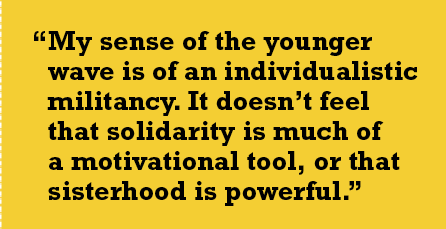 The second wave focused on “transforming institutions,” says Pogrebin, a founding editor of Ms. magazine, and the author of 11 books, including feminist classics like Getting Yours: How to Make the System Work for the Working Woman (1975), and the novel Single Jewish Male Seeking Soul Mate (2015) [See p. 12]. “My sense of the younger wave is of an individualistic militancy. It doesn’t feel as if solidarity is as much of a motivational tool, that sisterhood is powerful,” she adds. “We were interested in litigation and legislation as well as consciousness and mind-changing and altering social relations.”
The second wave focused on “transforming institutions,” says Pogrebin, a founding editor of Ms. magazine, and the author of 11 books, including feminist classics like Getting Yours: How to Make the System Work for the Working Woman (1975), and the novel Single Jewish Male Seeking Soul Mate (2015) [See p. 12]. “My sense of the younger wave is of an individualistic militancy. It doesn’t feel as if solidarity is as much of a motivational tool, that sisterhood is powerful,” she adds. “We were interested in litigation and legislation as well as consciousness and mind-changing and altering social relations.”
Both generations often worry about younger women who distance themselves from the word “feminist.” Rabbi Rachel Barenblat, 40, co-chair of ALEPH, the umbrella organization for the Jewish Renewal movement, says she feels generational tension when younger women “don’t see the value in the label or the identity.”
This happens in religious settings, too, like “Jewish day schools that have encountered considerable resistance from their bat-mitzvah-aged female students when they are encouraged or sometimes even required to wear tefillin during morning services,” says Raysh Weiss, 31, a Wexner Graduate Fellow and rabbinical student at the Jewish Theological Seminary and a co-creator of the YouTube video “If Men Rabbis Were Spoken To the Way Women Rabbis Are Spoken To.” “I wonder if these students simply take for granted the measures which earlier generations of Jewish feminists fought so hard
to implement.”
Political columnist and author Sarah Darer Littman, 52, says she too worries about this distancing from feminism. “If Emma Watson or Jennifer Lawrence talking feminism is the ‘gateway drug’ to getting young girls talking about the concept, then I’m all for it. Because that gives us a hook to lead them into discussions of the deeper issues.”
And which issues should be first among equals?
“Economic justice has to be a central issue of the feminist movement,” says Talia Cooper, 29, a youth educator, organizer, musician and the program director at Ma’yan, the women’s project at the JCC of Manhattan. She eschews “trickle-down feminism.” “If women are making it to the top and we’re in a culture that’s set up in a patriarchal, male-dominated world, that doesn’t help.”
“This thing that matters the most to me is the domestic sexism, that more expectations are placed on women,” says Elissa Strauss. “If you really look at the wage gap, it’s when women have kids. For this generation, millennial women are out-earning men until women start having kids, when everything changes….”
Seven Glorious Trends
In this swirling mix of shifting landscapes and priorities, seven things fill me with glee:
1. Feminism in pop culture and public discourse
2. Economic justice as a feminist issue (minimum wage, paid leave, domestic workers)
3. Conversations about intersectionality, privilege and gender justice
4. Men as allies and ambassadors (more, please)
5. Feminist call-outs & correctives: Hashtag activism, social entrepreneurs, accountability via media watchdogs (like the annual VIDA Count of how many women — or how few — are quoted as experts)
6. Killing the blame game, shifting culpability away from individuals and holding institutions, systemic structures and men accountable. For examples, Google “Slut: The Play,” or Sarah Silverman’s “Rape Prevention Tips”
7. Mentoring and communities of support (from informal discussion groups and Binder Con to organizations like Women, Action & the Media)
What-Shade-Is-Your-Pedicure Feminism
Today, the notion of “lipstick feminism” — with its embrace of traditional concepts like women’s sexual power co-existing with feminist ideas — seems old-hat.
Think about body image and gender identity. And how differently three Jewish feminists tackle it on TV right now: Jill Soloway (born 1965) with her family drama about Mort/Moira, the transgender parent coming out in “Transparent”; Amy Schumer (born 1981) with outrageous feminist satire on “Inside Amy Schumer”; and Lena Dunham (born 1986), whose “Girls” brought an everyday brand of millennial feminism to HBO.
But how about pedicures? What if “pedicure feminist” isn’t pejorative? What if it’s what you call someone who does more than avoid nail salons or choose a shade and tip (well), but who also thinks in the “Bread and Roses” tradition of Rose Schneiderman (born 1882) about how we can best support organizing efforts for the underpaid women — primarily immigrants — who work in nail salons to make sure basic labor protections are enforced?
Surely it’s better to define a feminist by her theory of change than by her appearance.
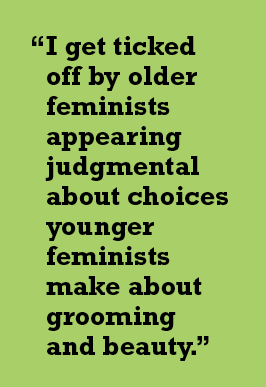
When I hear a self-identified feminist putting down another woman’s choices — the downside of call-out culture — I flip my metaphorical wig. If your analysis is that a patriarchal society creates self-hating women, then you probably don’t want to heap hate her way. Better to attack the larger systemic problems while doing what you can to empower women. My choices about appearance or marriage or motherhood reflect how I live my own feminism, but they aren’t — or shouldn’t be — a focus for judgement by other feminists. Do I think the personal is political? Absolutely. But the personal is also personal, and people are imperfect. I don’t live my feminist ideals in every single choice I make. And I don’t expect others to. Our collective feminist focus belongs on expanding all women’s choices, not on judging individuals for theirs, especially when 20 percent of women live in poverty. So, no, I have no desire to walk a day in your stilettos. But I want all roads open to you, whatever you’ve got on
your feet.
“Sometimes I get ticked off by women judging choices younger feminists make about grooming and beauty,” says Sarah Darer Littman. There’s a ‘You’re doing your hair, getting your nails done,’ for the ‘male gaze’ or ‘because patriarchy.’ I have really frizzy hair, for instance. I spend a few hours every six months getting it straightened. I don’t do it for men. I do it for me, because it saves time and money and it makes me feel good.”
We’d be foolish not to recognize that our choices send out signals. At one of my social-justice jobs, folks would say, “Think Yiddish, Dress British.” Meaning, if you want to introduce radical new ideas, blend in, so it’s your vision, not your appearance, that stands out.
Yet that’s not always the best approach. And certainly not the one taken by #FreeTheNipple, a campaign to have the same laws about nudity for both women and men while ensuring that public breastfeeding is respected, not criminalized.
In the American Jewniverse
“There’s a lot more attention to women’s issues than there once was,” says Rabbi Jill Jacobs. “When we talk about social justice, we’ll talk about what it means for low-wage workers, or slavery and trafficking. These are economic justice issues, but every single one of those has a gender justice angle.”
With more Generation X and Millennials leading Jewish newsrooms, women are shaping how the Jewish community understands itself. Since 2009, the Forward newspaper has investigated the gender gap via its annual survey of what top Jewish community professionals are paid. Editor Jane Eisner, who initiated the survey in 2009, wrote in a 2014 editorial that she’d hoped to spur a bigger shift in “the obvious gender imbalance.”
“My generation of feminists has been educated to know that we are as good and deserving as our male peers, and therefore we don’t take shit,” says Avigayil Halpern, 18.
“Fuck yeah, I’m a feminist,” says Jessie Kahnweiler, 30, creator of the series “The Skinny,” a dark comedy about bulimia. “You better believe if Sarah or Rebecca or Ruth were still around, they’d be on Twitter giving us their two cents.”

Is a Positive Call-Out Culture Possible? Yes.
Online creativity raises awareness and shifts attitudes, part of bigger pushes for change. Take Tumblr, where “100 Percent Schmucks” joins its secular peers “Congratulations, you have an all-male panel!” and “Having It Some” (co-created by a Jewish feminist, Sarah Seltzer), a platform for sharing (and exposing) family leave policies in various workplaces. Like the VIDA Count, these online accountability forums are call-out culture at its best.
One way to strengthen each other is to “be honest when conflict happens, and to approach each other as if we believe in the other’s capacity to grow,” says Shifra Bronznick, 61, founder of Advancing Women Professionals in the Jewish Community and co-author of Leveling the Playing Field.
Rabbi Danya Ruttenberg, 40, is the author of Surprised By God: How I Learned to Stop Worrying and Love Religion, and Yentl’s Revenge: The Next Wave of Jewish Feminism. She thinks younger feminists have “pushed me to be more thoughtful, a better thinker, they’ve called me out on my stuff in ways that are humbling and helpful.”
Similarly, consultant Sammie Moshenberg, 64, former director of Washington operations at the National Council of Jewish Women, describes ageism as “a huge problem. The organized Jewish community is very age-segregated, with traditional organizations (including women’s organizations) largely led by people of my generation or older. The women’s organizations covet younger feminists and spend a great deal of time and resources trying to figure out how to bring them into the fold. They ‘officially’ listen in the context of gatherings that they set up and control, but behaviors are harder to change.” Moshenberg says she’s grateful to “young colleagues for calling me on my comments and attitudes.”
Intersectionality & Privilege
The idea of intersectionality, a term that first flourished in feminist theory circles, has come to describe the ways we map out our complex identities. Oppression along race, class, ability, gender, and sexuality lines (among others) intersect in myriad ways, and we may hold privileges on one point on this grid but not on another. Just as Occupy Wall Street raised issues around economic justice, Black Lives Matter and the events in Ferguson and Charleston have pushed conversations about race, privilege, and intersectionality to the fore, including in American Jewish circles.
“I am multiracial, but I generally identify as a woman of color,” says the 30-something April Baskin, a diversity consultant and Director of Resources and Training at InterfaithFamily.com. “I see the world through three lenses, as a woman, as a person of color, and as a Jew. Sexism, class oppression and racism are inextricably bound together.” “Intersectionality is built into feminism,” says Rabbi Rachel Barenblat.
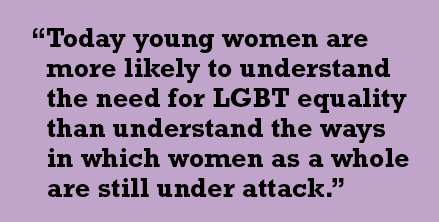
Now, we’re seeing feminist organizers building on the concerns of 1990s Third Wave Feminism, which sometimes took the Second Wave to task for being too white, too middle-class and too slow to understand how many women face multiple barriers.
“The early feminists of the 60’s and 70’s kicked out the lesbians,” laments Rabbi Denise Eger, 55, president of the Reform movement’s Central Conference of American Rabbis — the first lesbian to hold this position. “Today young women are more likely to understand the need for LGBT equality than understand the ways in which women as a whole are still under attack.”
Marjorie Dove Kent of Jews for Racial and Economic Justice kickstarted an important conversation in February in the Forward with “It’s Time for Black Jews to Lead.” April Baskin singles out social-justice organizations JFREJ and Bend the Arc for exploring ways “we can begin to shift our collective identity.”
Creating a Badass Jewish Feminist Future
It’s important to be mindful of where we’re weakest. But also to have fun, be proud and GSD. Like the Notorious RBG. (That’s get shit done and Ruth Bader Ginsburg, respectively, respectfully.)
“There’s activism and advocacy coming from all levels–healthy work-life policies, that’s exciting,” says Shifra Bronznick. “We’re seeing much more collaboration among the generations.”
Gabrielle Birkner, 35, founder of the Forward’s Sisterhood blog and now JTA managing editor, says, “I’m heartened by the way I see women supporting other women — celebrating their successes, promoting their ventures — in the digital sphere, and in communities like The Li.st (Rachel Sklar and Glynnis MacNicol’s networking platform). These are the best kinds of sororities.”
“Part of real feminist work,” says Rabbi Danya Ruttenberg, “is figuring out who you need to hand the mic to.”
Erica Brody is an editor and writer who has worked at the intersection of social justice, journalism and strategy, most recently as executive director and editor in chief of ZEEK Magazine.

